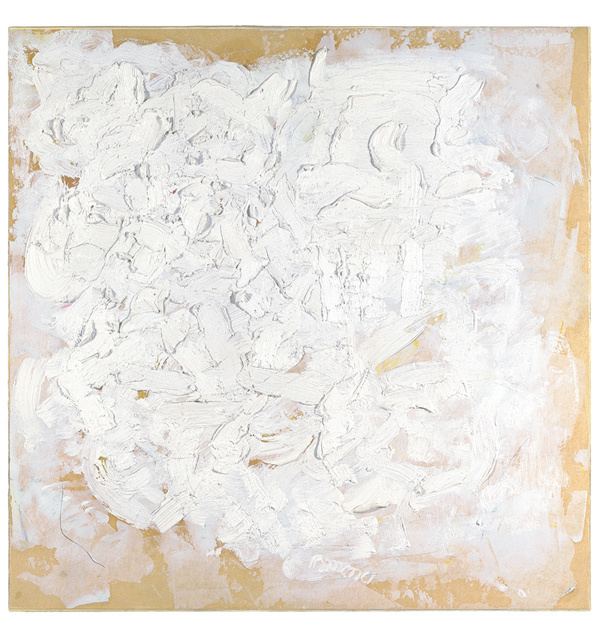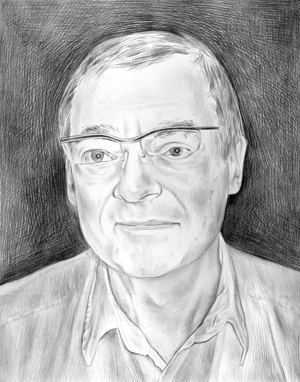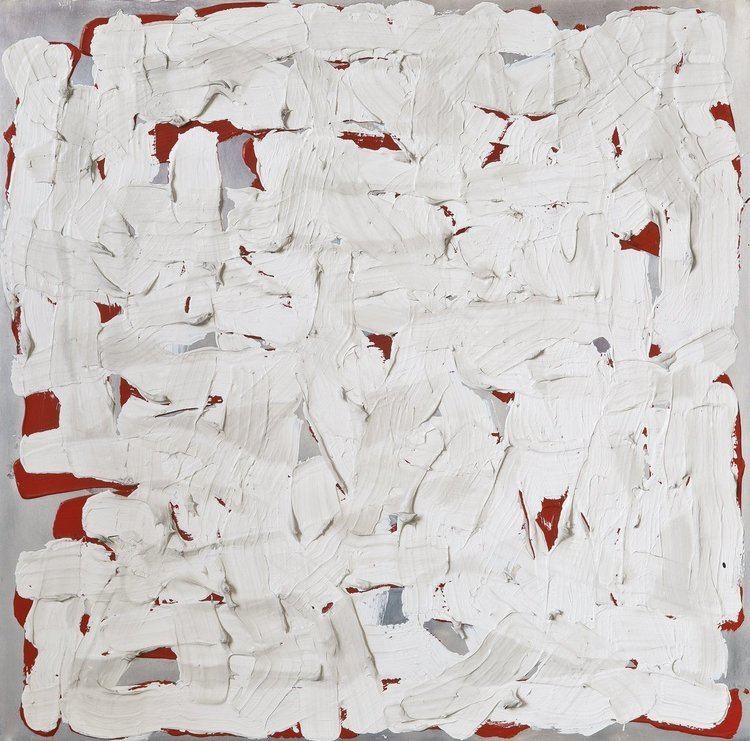Name Robert Ryman | Children Will Ryman | |
Education Peabody College (1949–1950) Artwork Surface Veil, Untitled Awards Guggenheim Fellowship for Creative Arts, US & Canada Similar People | ||
Extended version robert ryman variations and improvisations the phillips collection
Robert Ryman (born May 30, 1930) is an American painter identified with the movements of monochrome painting, minimalism, and Conceptual art. He is best known for abstract, white-on-white paintings. He lives and works in New York.
Contents
- Extended version robert ryman variations and improvisations the phillips collection
- Inside new york s art world robert ryman
- Early life and career
- Work
- Exhibitions
- Collections
- Recognition and reception
- Literature
- References

Inside new york s art world robert ryman
Early life and career

Ryman was born in Nashville, Tennessee. After studying at the Tennessee Polytechnic Institute, Cookeville, between 1948 and 1949, and at the George Peabody College for Teachers between 1949 and 1950, Ryman enlisted in the United States army reserve corps and was assigned to an army reserve band during the Korean War. Ryman moved to New York City in 1953, intending to become a professional jazz saxophonist. He had lessons with pianist Lennie Tristano, which later informed his painting. Ryman soon took a day job at the Museum of Modern Art as a security guard to make ends meet, and met the artists Sol LeWitt and Dan Flavin, who were co-workers with him at MoMA. Immediately after quitting his job at MoMA, Ryman spent the next year working in the art division of the New York Public Library. He also met artist Roy Lichtenstein during this period of the 1950s.

Captivated by the newly acquired abstract expressionist works of Mark Rothko, Willem de Kooning, Clyfford Still, Jackson Pollock and Barnett Newman, Ryman became curious about the act of painting. From 1953 to 1960, he worked at the MoMA as a guard in order to be close to painting. He purchased some art supplies at local store and began experimenting in his apartment in 1955. That year, Ryman finished what he considers his earliest professional work, a largely monochrome painting titled Untitled (Orange Painting) (1955–59).

Ryman had a close relationship with the late conservator Orrin Riley, who would frequently give him advice on archival materials, many times testing the acidity of media the artist was interested in using. He has been interviewed by the television writer and producer Barbaralee Diamonstein twice, once for the book and video production Inside New York's Art World in 1979 and again for Inside the Art World in 1993.
In 1961 the artist married art historian Lucy Lippard. They had a son together, Ethan Ryman, in 1964, who was a sound engineer and recently began making art. This marriage ended in divorce. He later married artist Merrill Wagner. Robert Ryman's sons, Cordy Ryman and Will Ryman are also artists and currently work in New York City.
Work
Ryman is often classified as a minimalist, but he prefers to be known as a "realist" because he is not interested in creating illusions, but only in presenting the materials he has used in compositions at their face value. As he wrote in a statement for a 2010 exhibition at Pace Wildenstein, "I am not a picture painter. I work with real light and space, and since real light is an important aspect of the paintings, it always presents some problems." The majority of his works feature abstract expressionist-influenced brushwork in white or off-white paint on square canvas or metal surfaces. A lifelong experimenter with media, Ryman has painted and/or drawn on canvas, linen, steel, aluminum, plexiglas, lumasite, vinyl, fiberglass, corrugated paper, burlap, newsprint, wallpaper, jute sacking, fiberplate, a composite material called gator board, feather board, handmade paper, and acrilivin. He has used painted and/or drawn with oil, acrylic, encaustic, Lascaux acrylic, casein, enamel, pastel, oil pastel, graphite, guache, and enamelac. Ryman has also experimented with printmaking, creating etchings, aquatints, lithographs, and silkscreens. His most famous quote is "There is never any question of what to paint only how to paint."
By the time Ryman began working, older artists like Barnett Newman, Mark Rothko, and Philip Guston had already reduced painting to its essences. In 1955 Ryman began what he considers his earliest professional work, a largely monochrome painting titled Orange Painting (1955–59). In the late 1960s he created his Classico series of compositions consisting of multi-panel paintings on a specific type of paper called Classico. For each work in the series, Ryman attached a configuration of heavy, creamy white sheets of the paper to a wall with masking tape, painted the sheets with a shiny white acrylic paint, removed the tape when the sheets were dry, mounted them on foamcore, and reattached them to the wall. The built-up paint edge tracing the outline of masking tape and the ripped paper left behind give witness to the process of creation. The various works in the Classico series differ in the organization of paper sheets, the configuration of tape traces, and the painted shape. Just as the Classico works were titled after the type of paper used as a medium, the so-called Surface Veil works from 1970 were named for the brand of fiberglass upon which the smaller pieces in this group were painted. Some of the 12-foot square paintings from the series were executed not on fiber-glass but on cotton or linen. In each of these works the pigment appears to form a membrane over the support due to the differing degrees of opacity and translucence in the white paint juxtaposed with areas where less of it has been applied, leaving the fabric exposed. These disruptions in the painting’s skin often mark the literal pauses between the artist’s working sessions.
From 1975 until the late 1990s, Ryman affixed his paintings to the wall with metal brackets. He would design each set of brackets specifically for each piece and have them constructed by a local metals fabricator.
In 2009 he participated in the art project Find Me, by Gema Alava, in company of artists Lawrence Weiner, Merrill Wagner and Paul Kos.
He has stated that his paintings' titles are meaningless, and that they only exist as a form of identification. Ryman actually prefers the term of "name" for a painting instead of a title because he is not creating a picture or making reference to anything except the paint and the materials. The "names" of paintings often come from the names of art supplies, companies, or are just general words that do not carry much connotation.
Exhibitions
Ryman had his first one-man show at Paul Bianchini's gallery, New York, in 1967 at the age of 36; his first show in Europe came the following year at the Galerie Heiner Friedrich, Munich. One year later, Ryman was included in When Attitudes Become Form, a seminal exhibition of works by Minimalist and Conceptual artists organized by the Kunsthalle Bern. His first one-man show at a museum was in 1972 at the Guggenheim Museum in New York City, displaying thirty-eight of Ryman’s works from 1965 to 1972. Ryman's works were represented in documentas 5 (1972), 6 (1977), and 7 (1982), in Kassel, in the Venice Biennale (1976, 1978, 1980), and in the Whitney Biennial (1977, 1987, 1995). His first retrospective was organized by the Stedelijk Museum, Amsterdam, in 1974. In 1992, a major touring retrospective of Ryman's paintings was mounted by the Museum of Modern Art and the Tate Gallery, including venues such as the Museo Nacional Centro de Arte Reina Sofia in Madrid, the San Francisco Museum of Modern Art and the Walker Art Center in Minneapolis.
Robert Ryman is represented by Pace Gallery in New York, and Xavier Hufkens in Brussels.
Collections
The Hallen für Neue Kunst, a former contemporary art museum in Schaffhausen, Switzerland (closed in 2014) had the largest public collection of Ryman's work, permanently exhibiting 29 pieces created from 1959 to 2007. In 2010 Ryman undertook a major reinstallation of his galleries at Hallen für Neue Kunst. Returning to the museum in 2008 — for the first time in 12 years — to revisit the permanent exhibition of his work that was first installed in 1983, he decided to transform the galleries into a “gesamtkunstwerk” — a synthesis, or total experience, composed of 30 paintings from 50 years of work.
In 2017, Ryman donated 21 painting to the Dia Art Foundation’s permanent collection, making it the only site with an extensive permanent grouping, featuring works made as early as the late 1950s and continuing up to 2003. Other major museums collecting his works include the Museum of Modern Art, New York; the Tate, London; the Art Institute of Chicago and the Stedelijk Museum in Amsterdam.
Recognition and reception
A recipient of numerous honors, Ryman has been awarded a John Simon Guggenheim Foundation Scholarship (1973), the Skowhegan Medal from the Skowhegan School of Painting and Sculpture (1985). He has been a member of the American Academy of Arts and Letters since 1994, and assumed the role of the organization’s Vice President in 2003.
In 2005, Ryman was awarded the Praemium Imperiale.
2009 saw the publication of Robert Ryman: Critical Texts Since 1967, edited by Vittorio Colaizzi and Karsten Schubert and published by Ridinghouse. The book charts the gradual evolution of the reception of and reaction to Ryman’s art. A comprehensive selection of over 60 essays and exhibition reviews has been collated into one volume, including texts by some of the most influential art historians and critics: Yve-Alain Bois, Donald B. Kuspit, Lucy R. Lippard and others.
Ryman's painting Bridge (1980) sold for $20.6 million at a Christie's auction in 2015.
